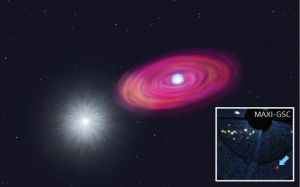 On 11 November 2011, astronomers witnessed a distant star erupt in an incredibly powerful explosion. An international research team including Mikio Morii and colleagues from the MAXI Team at the RIKEN Global Research Cluster has now reconstructed the event from a handful of telescopic snapshots, revealing for the first time the runaway fusion reaction that triggered the blast.
On 11 November 2011, astronomers witnessed a distant star erupt in an incredibly powerful explosion. An international research team including Mikio Morii and colleagues from the MAXI Team at the RIKEN Global Research Cluster has now reconstructed the event from a handful of telescopic snapshots, revealing for the first time the runaway fusion reaction that triggered the blast.
The whole process happened more quickly than is typical of novae. Yet it was also much fainter, implying that relatively little mass was ejected in the explosion. The team’s findings suggest that the white dwarf was unusually massive, giving it a higher surface gravity that put the accumulated material under even greater pressure. This meant that less fuel was needed to trigger the explosion and a briefer nova with less ejecta was produced.

